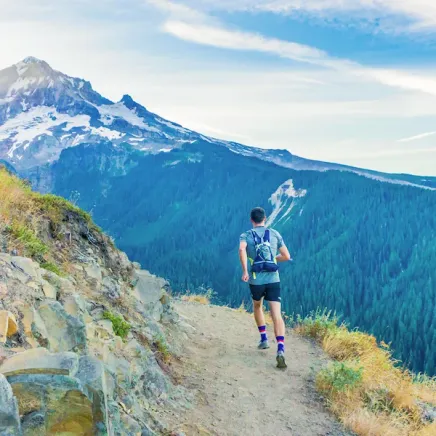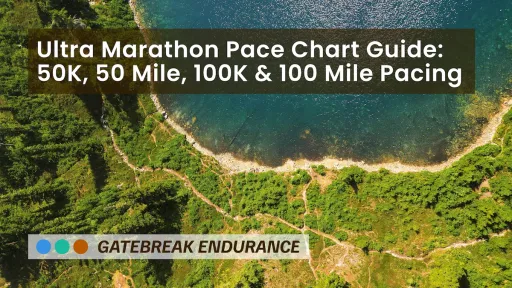Ultramarathon Pace Charts: 50K, 50M, 100K & 100M Strategies

- 50K vs 50 mile isn't just 19 more miles - it's almost an entirely different sport
- There's no shame in power-hiking (or walking)

IN THIS ARTICLE
Why Ultra Marathon Pacing Is Different
Ultra marathon pacing fundamentally differs from road racing strategy. While marathon and half-marathon success often rewards aggressive early pacing and negative splits, ultra distances punish going out too fast with exponential late-race consequences.
Ultras often traverse challenging terrain rather than predictable road courses. Trail surfaces vary from technical single-track to gravel fire roads, often featuring dramatic elevation changes, altitude variations, and unpredictable weather exposure. A runner might encounter scorching desert heat, alpine cold, and everything between during a single race.
Terrain dictates pacing more than fitness. The same athlete capable of maintaining 9:00 pace during a flat road 50K might struggle to average 12:30 pace on a mountainous course with significant elevation gain. Weather and altitude compound these challenges exponentially over ultra distances.
Beyond terrain considerations, ultra distances demand skills rarely needed in shorter races: strategic hiking, more complex fueling protocols, and mental resilience during multi-hour efforts. At 30+ miles, success can depend more on mental fortitude and energy management than cardiovascular fitness.
Ultra Marathon Pacing Chart: Quick Reference
50K Ultra Marathon Pacing
The 50K distance lures marathon runners and first-time ultrarunners with the deceptively simple promise of being a mere 5 miles longer than a marathon distance. At 31 miles, it's deceptively close to marathon distance. But make no mistake, those 5 additional miles fundamentally change race strategy and outcomes.
Road marathoners with limited trail experience often overlook the difficulty of running over varied terrain. 50K courses that host considerable elevation gain over 31 miles of rocky and root-laden single-track may deceive fast marathoners into an unsustainable pace. Many marathon-trained athletes cruise through the first 20 miles, but the final 10 miles become a masterclass in pacing, fueling, and mental resilience.
First Time Pacing Principle: Start slower than your road marathon pace. On technical trail courses with significant elevation, expand this cushion further. The goal is reaching mile 20 feeling controlled and sustainable, not depleted.
The Critical Challenge: While marathoners often find their strongest miles in the final 10K, 50K runners frequently hit their lowest point here. This is where early pacing discipline pays dividends. Athletes who preserve energy during the first 20 miles maintain forward momentum when others are forced into survival mode.
Success Strategy: Hiking uphill becomes a critical tool. Dial your nutrition in training to avoid GI distress during your race. Train consistently, trust your training, and maintain a sustainable pace early in the race.
50 Mile Ultra Marathon Pacing
See the full 50 Mile Pace ChartThe counterintuitive truth: Many runners benefit from attempting a 50 miler before a 50K. While conventional wisdom suggests progressive distance building, 50K's deceptive similarity to marathons lures athletes into unsustainable pacing. A 50 mile race forces conservative strategy from mile one.
The additional 19 miles beyond a 50K fundamentally transform the experience. This isn't simply a "longer 50K" - it's where ultra running becomes ultra survival. What begins as an extended long run evolves into all-day endurance management, often spanning 8-14+ hours.
Critical Reality Check: Even elite 50 mile athletes incorporate significant walking and power-hiking. Unlike marathons where walking signals failure, strategic hiking becomes essential for completion. Only the most experienced ultra runners maintain continuous running throughout the entire distance.
Pacing Principle: Abandon traditional road-marathon time-banking strategies entirely. Focus on energy conservation over speed. Depending on the course, you can expect your average pace to slow 2:00-3:00 minutes per mile compared to marathon pace, with environmental stress potentially adding additional time. Many successful 50 milers adopt run-walk patterns from the opening miles: hiking all climbs while running the course’s flats and gentle descents.
The Defining Challenge: The notorious mile 35-40 breakdown zone. After 6-8 hours of accumulated impact on feet, legs, and digestive system, this is where early pacing mistakes and inadequate nutrition become catastrophic.
100k Ultra Marathon Pacing
100K Pace Chart: Check out our 100K pace chart page to help you guide your training, understand the average target pacing you need to avoid course cutoffs, and have a great race.
The forgotten distance that might be your secret weapon. While runners obsess over 50 milers and 100 mile buckles, the 100K (~62 miles) quietly offers something neither can: your first true apprenticeship with darkness.
Ah you think darkness is your ally? You merely adopted the dark. I was born in it, molded by it.
- Bane
At 62 miles, the 100K serves as the perfect stepping stone between 50 mile survival and 100 mile mastery. More importantly, it's often the first ultra distance that forces athletes to run into the night - a skill that becomes essential for 100 mile events and beyond.
The Night Training Ground: Most 100Ks begin at sunrise and finish well after sunset, creating a unique challenge that are less common with 50 mile races. You'll experience the full cycle of energy peaks and valleys, learning to manage your body clock when it's screaming for sleep while your legs are still expected to move forward.
Pacing Principle: Treat the 100K as an exercise in effort management, not pace control. Average paces often drops 2-4 minutes per mile slower than marathon pace on trail courses, with even greater disparities for technical terrain with considerable elevation.
The Defining Challenge: Embracing darkness (night running) and managing fueling protocols. Overnight mental lows often prove more challenging than physical fatigue. The athletes who thrive are those who've practiced overnight training runs, night 50Ks, or back-to-back long efforts in their training.
Distance Education: The 100K teaches skills that 50 milers can't provide: headlamp strategies, night fueling tolerance, and the mental resilience needed for true overnight efforts. These lessons become valuable for anyone considering 100 mile distances.
100 MIle Ultra Marathon Pacing
The 100 mile ultra is a different sport entirely. Spanning 24–30+ hours, it demands not just endurance, but patience, logistics, and resilience through multiple physiological and mental cycles.
Pacing principle: Manage your nutrition and tailor your pace to the course. Employ strategic power-hiking and walking to maintain steady forward progress without hindering your ability to finish the event.
Unique challenge: Night sections and circadian rhythm. You’ll likely spend 8–12 hours moving in the dark, after a full day of racing. Night brings fatigue, temperature drops, and mental lows. Planning caffeine use, layering, and night gear becomes as critical as pacing. Many runners break the race into “mini ultras” of 20–25 miles to make the distance psychologically manageable.
Ultra Marathon Pacing Strategy
Start Slower than Feels Natural
The most critical ultra pacing advice: go out slower than instinct suggests. Even experienced marathoners fall victim to early-race enthusiasm, but ultra distances amplify the consequences.
Unlike shorter races where aggressive pacing creates immediate discomfort, ultra pace mistakes feel comfortable initially. Your "too fast" ultra pace might match your daily training pace, creating false confidence that compounds into disaster late in the race.
The one-third rule: Divide your race into thirds, ensuring your effort during each section allows completion of the final third. During the first 10 miles of a 50K, run at an intensity that leaves energy for the final 10 miles. If you notice a significant gap between current comfort and projected late-race capability, slow down immediately.
Banking 5 minutes through the first 10 miles by running 15-30 seconds per mile faster becomes worthless if you're forced to walk the final segments. Worse, overly aggressive early pacing can lead to DNF (Did Not Finish), the ultimate pacing failure.
For most runners, conservative pacing trumps personal best attempts. If chasing time goals, ensure your training specifically supports that pace with injury prevention protocols. Aerobic capacity develops through experience and consistent training, not race-day heroics.
Maintain Sustainable Effort and Monitor Intensity
After controlling pre-race adrenaline and establishing conservative early pacing, focus on sustainable effort throughout the remaining distance.
Fuel system management becomes critical. Higher running intensities shift your body toward carbohydrate burning, rapidly depleting glycogen stores essential for ultra completion. Running too hard without proper fuel replenishment creates the dreaded "bonk," a metabolic wall akin to “hitting the wall” during a marathon..
Maintaining consistent effort proves easier than recovering from deep energy deficits. On mountainous courses, embrace power-hiking and walking as strategic tools rather than signs of weakness or failure. Make the decision to hike before your heart rate spikes and the intensity becomes unsustainable.
Practice walking efficiency during training runs - proper hiking form and strategic walk breaks prevent the cardiovascular stress that forces unplanned walking later in races.




